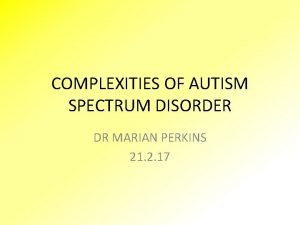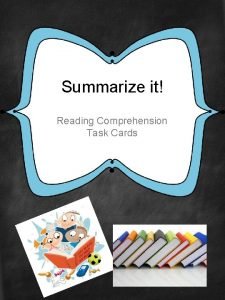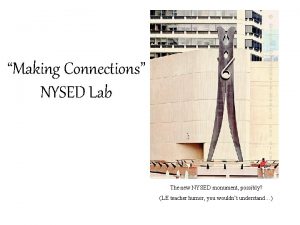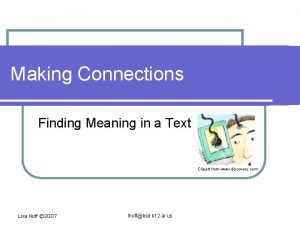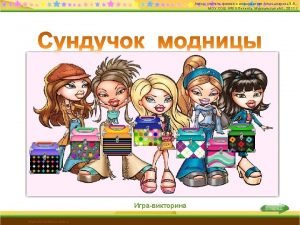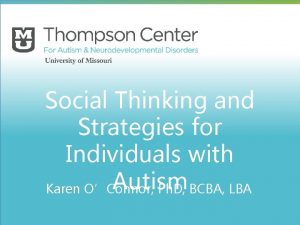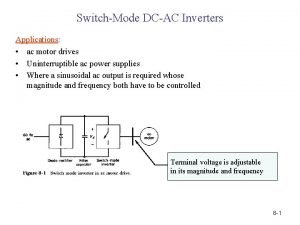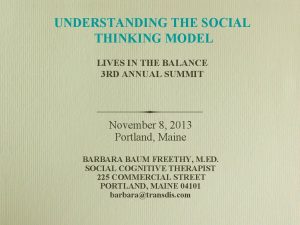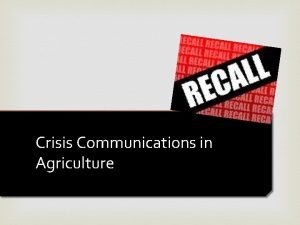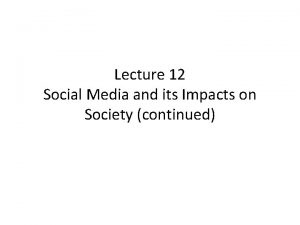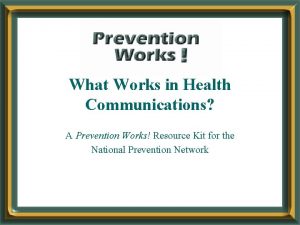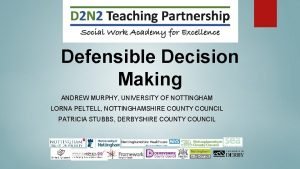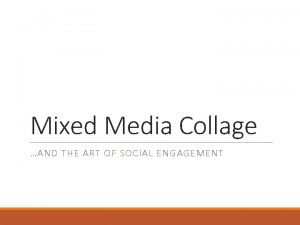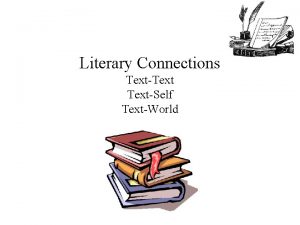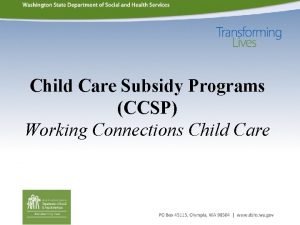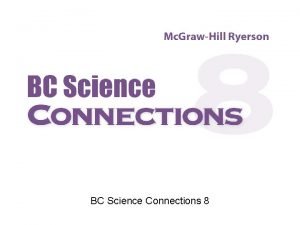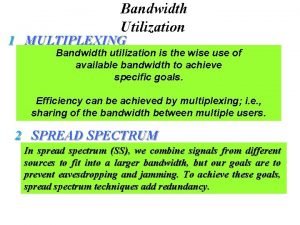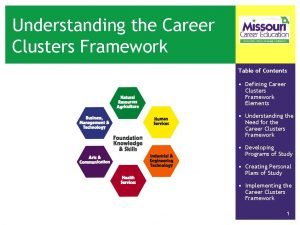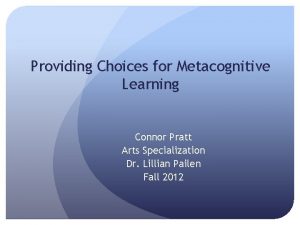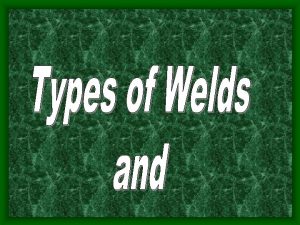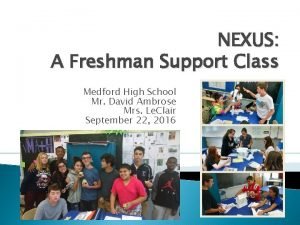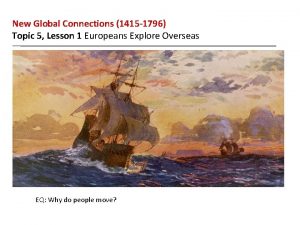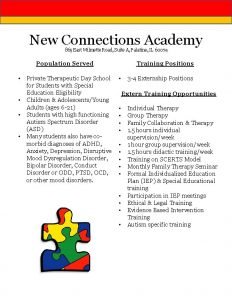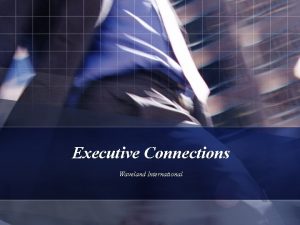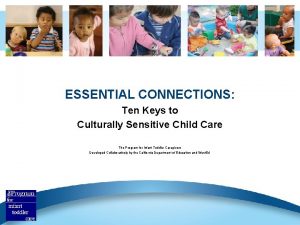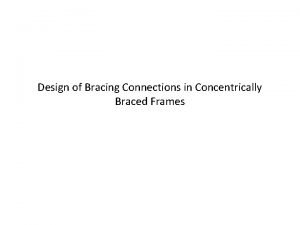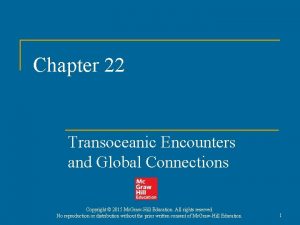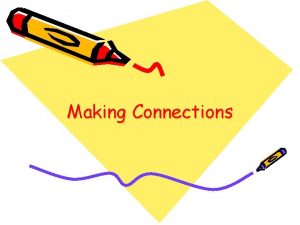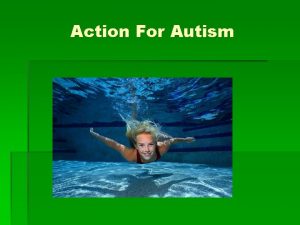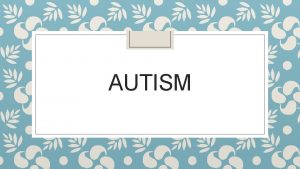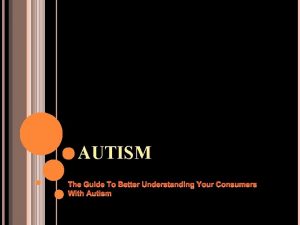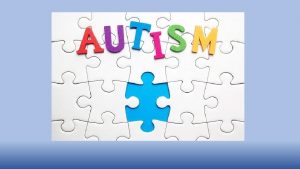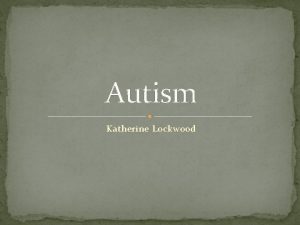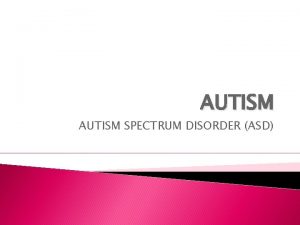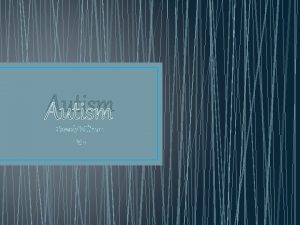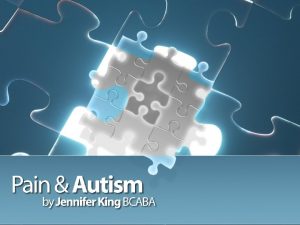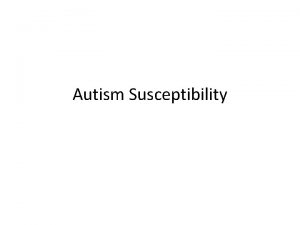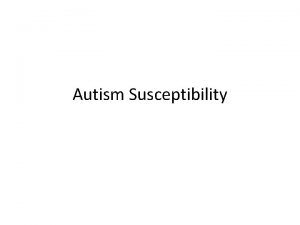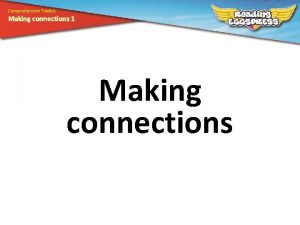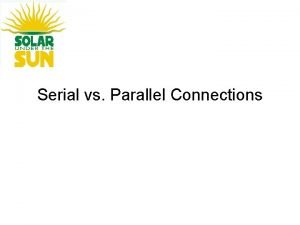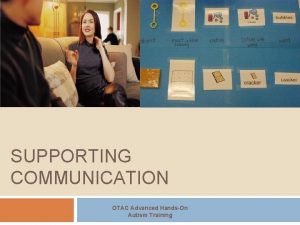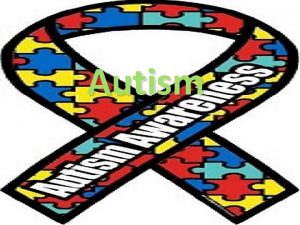Autism 200 Lecture Series Making Connections Social Communication



























































- Slides: 59

Autism 200 Lecture Series Making Connections Social Communication May 19, 2011 James Mancini MS, CCC -SLP

Communication • Takes place 24/7 • Needs to involve parent/school collaboration • Dynamic • Difficult to make change in 1 hour/week

CONTEXT!

Objectives • Define social communication • Identify several delay/differences in ASD • Provide strategies to use at home and school

Diagnostic Statistical Manual-Fourth Edition (DSM-IV) • Communication (1 or more of the following): • Delay in or total lack of development of spoken language • Marked impairment in the ability to initiate or sustain conversation • Stereotyped and repetitive use of language • Lack of varied, spontaneous make-believe play or social imitative play appropriate to developmental level

DSM-IV Criteria for Autism (cont. ) • Social Interaction (2 or more of the following): • Marked impairment in nonverbal behaviors • Failure to develop peer relationships at developmental level • Lack of spontaneous sharing of enjoyment, interests or achievements • Lack of social or emotional reciprocity

Diagnostic Statistical Manual-Fourth Edition (DSM-IV) • Communication (1 or more of the following): • Delay in or total lack of development of spoken language • Marked impairment in the ability to initiate or sustain conversation • Stereotyped and repetitive use of language • Lack of varied, spontaneous make-believe play or social imitative play appropriate to developmental level

DSM-IV Criteria for Autism (cont. ) • Social Interaction (2 or more of the following): • Marked impairment in nonverbal behaviors • Failure to develop peer relationships at developmental level • Lack of spontaneous sharing of enjoyment, interests or achievements • Lack of social or emotional reciprocity

Social Reciprocity • The ability to both socially respond, socially initiate and manage interactions in a give and take manner. Often, children with ASD can either respond or initiate social interactions but have difficulty with sustaining reciprocity during conversations or social interactions.

Social Response • “Taking in” information from others, processing, and responding appropriately to the context • Good responders will look better during adult -led interactions but have difficulty when interactions are not facilitated • “Passive” children can sometimes be better responder than initiators

Social Initiation • Beginning social interactions and communication • Some children are better at initiating (usually to serve own needs) • Will often have difficulty with social response (processing what others’ are saying to him and responding appropriately)

Social Communication • UW Speech and Hearing Department: http: //depts. washington. edu/soccomm/model. html

Executive Functions • Enable a child to access and utilize available social knowledge and world experience • Organizing and making sense of incoming information (verbal and nonverbal) • Formulating a contingent response • Perspective Taking

Processing Abilities • Auditory Processing • Visual Processing • Other sensory processing and integration • Attention • Shared Joint Attention

Social Cognition • The social “rules” • Knowing what to do or say given a situation • Knowing how to modify what you say based on the CONTEXT

Language • Language (Understanding and Expression) • Grammar (syntax) • Vocabulary (semantics)

Nonverbal Communication • • Gestures Eye Contact Facial Expression Emotion/Affect

Social Communication: Putting it all together • Using language & nonverbal communication to communicate socially within CONTEXT • Involves coordination of: • • • Words Gestures Facial Expression Eye Contact Affect


Encouraging Communication • Recognize how your behavior influences changes in development • Two Examples • Changing own behavior to help your child • • • Facilitate more sophisticated communication Language Eye Contact Follow routines Consistency/Predictability Simplifying language

Pre-Intentional Communicators • Caregivers need to interpret behavior to determine needs and desires • Child gets what they want without making requests • Non-directed vocalizations • Crying, screaming, tantrums • Often associated with frustration

Intentional Communicators • Use of others’ bodies to communicate (leading or placement of others’ hands on objects) • Giving to obtain help • Directed vocalizations • Gesture use – pointing, arms up, showing objects to share • Beginning to use words (symbolic communication)

Pre-Verbal Communication • Communication that does not involve words • Gestures • Eye Contact • Vocalizations

Foundation of Social Communication • Engagement • Joint Attention • Imitation

Engagement! • • • Motivation to be social? Social Initiation Social Response Attention (eye contact) Use of eye contact and facial expressions (affect) during interactions (e. g. social smiling)

Increasing Engagement • Use preferred activities to create social opportunities (bubbles, balloons, peeka-boo!) • Take control of preferred objects; control access • Create predictable and enjoyable social routines • Extrinsic vs. Intrinsic Motivation

Joint Attention • Response (pointing, head turns, eye gaze) • Initiation (pointing, eye contact, maybe verbalization, eye gaze shifting) • Shared joint attention to objects, activities, books, etc is main vehicle for learning

Joint Attention • Placing objects of interest out of reach and shifting the child’s attention to them by pointing and/or looking (response to joint attention) • Facilitating pointing and eye gaze when making requests (initiation) • Initiating joint attention – necessary skill for making comments

Imitation • Imitation – social act and important for reciprocity • Should be an Initial Goal • Imitation includes: • • • Motor (gross and fine) Play actions Verbal Gestures Facial Expressions

Imitation • Contingent imitation – imitate what child says or does, facilitate imitation • Can begin with gross motor imitation and try to facilitate verbal • Physical prompting can be used for motor imitation • Singing favorite songs or playing social games that involve imitation • Wheels on the bus; Head, Shoulders… • Ring around the Rosie, Simon Says

Meaning • Attaching meaning to words (language) – words as symbols • Vocabulary: Objects Figurative Language • Gestures • Pretend Play • Changes depending on the context

Encouraging Communication • Modeling and Imitation • Increasing vocabulary • Providing opportunities to practice • Verbal • Nonverbal • Opportunities in books, movies, across contexts • Need for generalization

Why do we communicate? Communicative Intentions • • • Gaining Attention Making requests Making comments Greeting/Saying good-bye Protesting Responding to others • AND…coordination of words, gestures, eye contact and affect for communication intentions

Requests • • • Using others’ bodies Giving objects to ask for help Reaching Pointing Verbal Coordination of eye contact with requests

Increasing Requests • Modifying the Environment • Set up opportunities to communicate by placing preferred objects on a shelf or in a box • Create a visual choice board • Sabotage • Be a communication coach!

Protests • • • Pushing/turning away Taking hands off of objects Shaking head Verbally saying “no” Connection with emotional regulation

Increasing Protests • Model and replace less sophisticated communication • Provide opportunities to practice • Write social stories that provide structure for protests • “Practice” by role playing

Commenting • Communication for purely social purposes • Commenting vs. labeling • Showing • Pointing • Verbally commenting • Initiating joint attention – coordination of eye contact with communication

Nonverbal Communication • Use and Interpretation involving: • Eye Contact • Facial Expressions • Gestures

Eye Contact • • How we gain information about others How we “read” other people How we interpret others’ actions The coordination of eye contact with other communicative abilities is how we become SOCIAL • Social Referencing –”Checking In” (gaining permission • Paired with facial expressions during nonverbal communication

Eye Contact • Indirect cues – pausing during social routines • Become interesting to your child – acting silly or doing something unusual to pique interest • Take language out of communication – play nonverbal games • Avoid “look at me” (unless a last resort)

Facial Expressions • How we communicate emotion • Often emotional extremes (happy and frustrated) • Better at expression than receptive understanding (paired with perspective taking and understanding of emotions) • Reading social cues

Facial Expressions • Digital Cameras – Take pictures of familiar people making different facial expressions and practice

Gestures • Pointing! • Conventional gestures: waving, nodding, shaking head, “where”, etc. • Descriptive gestures: “big”, “fast”

Gestures • Lots of Modeling • Play a game where you communicate only via gestures • Imaginative Play • Red Light/Green Light • Take language out of communication

Precursors to Conversations • Asking/Answering Questions • Answering questions that involve “thinking” • Relating personal events • Asking “relevant” questions • Turn-taking

Narratives • Relating personal events in simple terms • Talking about the past (outside of “here and now”) • Relating daily events (“what happened at school today? ”) • Difficulty with organization, sequencing, and recall • Difficulty retelling stories from books

Narratives • Relating events • Sequencing cards/”How” questions • Books (telling and re-telling stories) • Practice talking about an event and then direct them to tell someone else) • Create your own books with digital pictures (especially events like birthdays, holidays, vacations) • Ask specific questions rather than openended questions

Conversational Skills • Reciprocal Verbal Exchange of: • Information • Personal stories/narratives • Social sharing • Requires attention to others, perspective taking, social knowledge, social response, social initiation, more!

Conversational Skills • Includes: • Asking/Answering questions • Ability to relate events and attend to others • Lots of nonverbal behaviors: eye contact, facial expressions, gestures (nodding to acknowledge; confused looks) • Need to adjust to context!

Perspective Taking (Theory of Mind) • The ability to imagine what someone is else is thinking or feeling • “Do you know what I know” • Or…denying what you know to be true • Important ability in social interactions – how we modify what we do or say given the context of the situation

Perspective Taking • Books – what are characters thinking/feeling • Movies • Drama – role playing • Games that involve strategy – knowing what others’ know • Clue Jr. • Mancala, chess, Tic Tac Toe, Connect 4

Reading Social Cues • Involves: • Attention to others • Eye contact • Recognizing facial expressions and how they link to emotions • Social Knowledge • Appropriate social response • Depends on CONTEXT!

Higher Level Conversational Skills • Conversational development doesn’t stop with turn-taking and topic maintenance • Complex system involving • • • Executive Functioning World knowledge and social rules Social Reciprocity Nonverbal Interpretation CONTEXT!

Parent Involvement • Targeting social communication requires a TEAM approach • Consistency • Generalization • Educating and communicating with parents regarding targets and strategies will increase progress toward goals • Training in schools – Have communication expert in school provide in-services regarding how to facilitate communication in context

Assessments should consist of: • Combination of: • Structured testing • Observation • Parent report • Teacher report

Cautions related to standardized testing • Often over-estimate language abilities (PLS 4) • Provide visuals and require short answers • Miss out on social communication (context!) • Avoid tests that are highly specific (e. g. PPVT) unless examining that specific area • Be wary of “pragmatic” standardized tests (TOPL) • Be sure to combine standardized tools with less formal assessment and observation

Social Communication • Children with ASD who have language that is “within normal limits” usually have deficits in social communication development

Thank you! Jim Mancini MS, CCC-SLP james. mancini@seattlechildrens. org
 100 200 300
100 200 300 Social pragmatic communication disorder vs autism
Social pragmatic communication disorder vs autism Making connections task cards
Making connections task cards Making connections lab
Making connections lab Text to text connection examples
Text to text connection examples Text-to-media connection
Text-to-media connection Text to self clipart
Text to self clipart Tug of war
Tug of war 01:640:244 lecture notes - lecture 15: plat, idah, farad
01:640:244 lecture notes - lecture 15: plat, idah, farad 200+200+100+100
200+200+100+100 600+800+800
600+800+800 300+300+200+200
300+300+200+200 200 + 200 + 300
200 + 200 + 300 100 + 100 200
100 + 100 200 200 + 200 + 300
200 + 200 + 300 Social thinking autism
Social thinking autism Geology lecture series
Geology lecture series Dcac lecture series
Dcac lecture series Michelle garcia winner double interview
Michelle garcia winner double interview What is inferring
What is inferring War making and state making as organized crime
War making and state making as organized crime Social thinking adalah
Social thinking adalah Social thinking social influence social relations
Social thinking social influence social relations Maclaurin series vs taylor series
Maclaurin series vs taylor series Heisenberg 1925 paper
Heisenberg 1925 paper Taylor vs maclaurin
Taylor vs maclaurin Deret maclaurin
Deret maclaurin Ibm p series
Ibm p series Amount of feedback
Amount of feedback Series aiding and series opposing
Series aiding and series opposing Arithmetic series formula
Arithmetic series formula Crisis communications lecture
Crisis communications lecture Business communication lecture slides
Business communication lecture slides Social psychology lecture
Social psychology lecture Lecture about social media
Lecture about social media Making health communication programs work
Making health communication programs work Defensible decision making in social work
Defensible decision making in social work Collage making on social issues
Collage making on social issues Watson career and alumni connections
Watson career and alumni connections Forced connections examples
Forced connections examples Text to self examples
Text to self examples Balanced wye-wye connection
Balanced wye-wye connection Steel girder truss design
Steel girder truss design Working connections child care
Working connections child care Bc science connections 8 download
Bc science connections 8 download Four 1 kbps connections are multiplexed together
Four 1 kbps connections are multiplexed together Yakima neighborhood clinic
Yakima neighborhood clinic Architecture and construction career cluster definition
Architecture and construction career cluster definition Learning connections inventory
Learning connections inventory Types of welding joints
Types of welding joints Nexus connections academy
Nexus connections academy Topic 5 new global connections
Topic 5 new global connections New global connections test answers
New global connections test answers New connections academy palatine
New connections academy palatine Native connections housing
Native connections housing Build executive connections
Build executive connections Essential connections
Essential connections Ru
Ru Chem connections india
Chem connections india Chapter 22 traditions and encounters
Chapter 22 traditions and encounters

